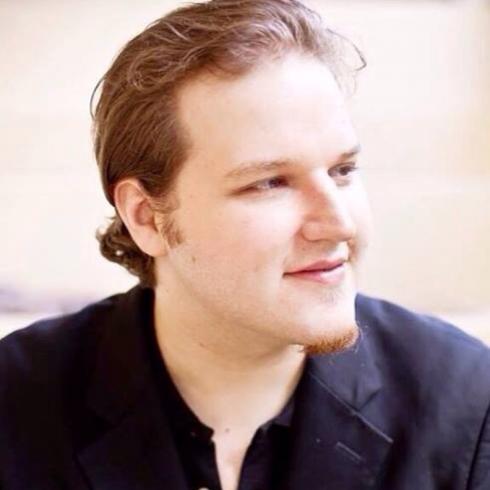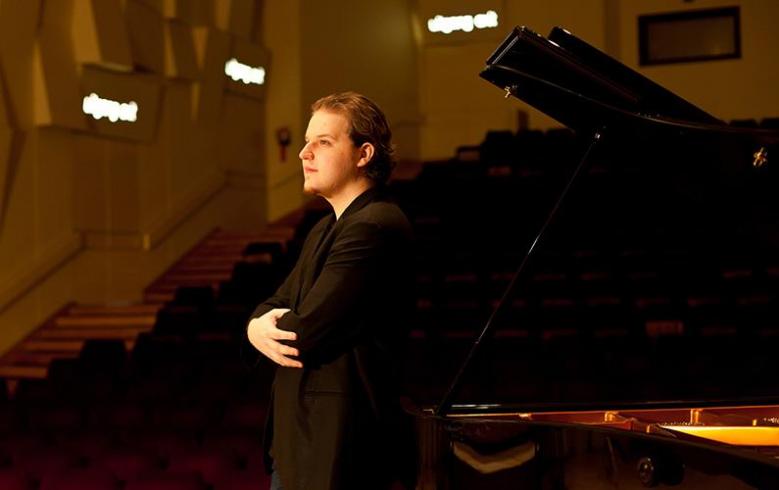Lukáš Vondráček
Piano

Lukáš Vondráček will make his Phillips debut with selections by W.A. Mozart, Liszt, Smetana, and Brahms.
Program
Czech pianist Lukáš Vondráček had already appeared as a soloist with leading orchestras in the USA and Europe before winning the renowned Queen Elisabeth Competition in 2016—previous winners included Emil Gilels, Leon Fleisher, and Vladimir Ashkenazy. Vondráček made his debut with the Czech Philharmonic in 2002 at age 15, with Ashkenazy conducting. In this recital, he presents sonatas by Mozart and Brahms alongside Liszt’s Ricordanza (memorably described by Busoni as “a bundle of faded love-letters”) and a group of Smetana’s Czech Dances, music that is imbued with the spirit of Vondráček’s homeland.
PROGRAM:
WOLFGANG AMADEUS MOZART (1756-1791)
Piano Sonata No. 10 in C Major, K.330 (1783)
Allegro moderato
Andante cantabile
Allegretto
FRANZ LISZT (1811-1886)
Étude No. 9 in A-flat Major, “Ricordanza” S.139 (1851)
BEDŘICH SMETANA (1824-1884)
Czech Dances II, JB 1:114 (1879)
Hulán
Cibulièka
Furiant
Intermission
JOHANNES BRAHMS (1833-1897)
Piano Sonata No. 3 in F minor, Op. 5 (1853)
Allegro maestoso
Andante: Andante espressivo
Scherzo: Allegro energico
Intermezzo: Andante molto
Finale: Allegro moderato ma rubato

About the Artist
Lukáš Vondráček made his first public appearance at the age of four. His debut as a fifteen-year-old in 2002 with the Czech Philharmonic Orchestra and Vladimir Ashkenazy was followed by a major US tour in 2003. His natural and assured musicality and remarkable technical ability have long marked him as a gifted and mature musician. He has worked with conductors including Paavo Järvi, Gianandrea Noseda, Marin Alsop, Christoph Eschenbach, Zdeněk Mácal, Pietari Inkinen, Vasily Petrenko, Jakub Hrůša, Christoph Poppen, and Anu Tali.
Highlights of the 2014/15 season include concerts with the Trondheim Symfoniorkester and Krzysztof Urbański and the Orquestra Sinfônica do Estado de São Paulo and Marin Alsop. Lukáš gives a recital at the Queen Elizabeth Hall in London as part of the International Piano Series where, in 2007, he made his UK recital debut as the youngest pianist to have featured in this series.
Recitals have taken Lukáš to London’s Wigmore Hall, New York’s Carnegie Hall, Zurich’s Tonhalle, Vienna’s Konzerthaus, Amsterdam’s Concertgebouw, Casa da Música in Porto, Palais des Beaux Arts in Brussels, Cité de la Musique in Paris, Auditorio Nacional de Madrid, Washington Performing Arts Society, Boston Celebrity Series as well as Festival La Roque d’Anthéron and Gilmore Festival.
He works regularly with ensembles such as the London, St Petersburg and Royal Liverpool Philharmonic orchestras; the Philharmonia and Gulbenkian orchestras, Wiener Symphoniker, Tonhalle-Orchester Zürich, Deutsches Symphonie-Orchester Berlin, NDR Sinfonieorchester Hamburg, NHK Symphony Orchestra and Washington’s National and Cincinnati Symphony orchestras. Recent highlights include a tour of Spain with the Orquesta Sinfónica de Euskadi and Michał Nesterowicz and a highly successful tour of Australia including appearances with the West Australian and Sydney Symphony orchestras.
Following studies at the Academy of Music in Katowice and the Vienna Conservatoire Lukáš Vondráček obtained an Artist Diploma from Boston’s New England Conservatory under the tutelage of Hung-Kuan Chen, graduating with Honours in 2012. International awards include first prizes at the Hilton Head and San Marino International Piano Competitions and Unisa International Piano Competition in Pretoria, South Africa, as well as the Raymond E. Buck Jury Discretionary Award at the 2009 International Van Cliburn Piano Competition.
His first commercial recording, a solo album for Octavia Records featuring works by Mendelssohn, Liszt, Janáček and Dohnányi, was released in 2004. A second recording, for Two Pianists Records, followed in 2012 and featuring works by Haydn, Rachmaninov and Prokofiev. His most recent disc – a Brahms recording entitled Im Gläsernen Schloss was released in autumn 2013 on the ORF label.
Notes
Notes by Nigel Simeone
WOLFGANG AMADEUS MOZART (1756-1791)
Piano Sonata in C Major, K330 (1783)
The first of a set of three sonatas composed in 1783 and published the following year, the Sonata in C Major takes the elegant keyboard style developed by Johann Christian Bach and others and adds the warmth and lyricism typical of Mozart’s music from this period. The gentle first movement is almost entirely unruffled, but it is not without some subtle harmonic turns, especially in the development section. The Andante cantabile is in F Major, dominated by a noble song-like theme. At the center of the movement the music turns to F minor for a mysterious passage, later recalled in the Major key to provide a magical coda. The concluding Allegretto has a succession of genial themes as well as plenty of pianistic brilliance.
FRANZ LISZT (1811-1886)
Étude No. 9 in A-flat Major, “Ricordanza” S.139 (1851)
Liszt’s Douze etudes d’exécution transcendante of 1851 have their origins in the set of studies published in 1837, which in turn were based on ideas dating back as far as 1826, when Liszt was 15 years old. The distinctly operatic main tune of Ricordanza (“Remembrance”) was one of those teenage inspirations, but a treatment from 1851 reveals the boldness, inventiveness and seasoned mastery of Liszt’s maturity. Ferruccio Busoni described this great étude and its three successors in the series as “like a packet of yellowing love-letters,” a wonderfully apposite description, especially for Ricordanza. While this music is full of technical demands, what matters far more is its intensely tender and poetic expressiveness.
BEDŘICH SMETANA (1824-1884)
Czech Dances II, JB 1:114 (1879)
Smetana’s two sets of Czech Dances are his most overtly nationalistic piano works, more intimate than his great patriotic operas or the great symphonic cycle of Má vlast, but no less imbued with the spirit of his homeland. In 1924, Leoš Janáček wrote that Smetana’s rhythms “are as if their beds were made on Czech native soil. The Czechness of the music is such that it is almost possible to measure it. Music has its share of Czechness, as does the character of the people, the region, and the land where they live. … The shining light of Bedřich Smetana will stay among us always.”
Having composed four extremely creative reinventions of the polka as the first set of Czech Dances in 1877, the second set explores other traditional Bohemian dances. Smetana was inspired by his younger contemporary Antonín Dvořák, whose first set of Slavonic Dances were published in 1878 for piano four-hands. From 1876 until his death in 1884, Smetana’s permanent home was at Jabkenice, 40 miles North-East of Prague, where his son-in-law was a forester. The setting was idyllic – surrounded by woodland and lakes – and Smetana lived in the gamekeeper’s lodge. Living in the cottage opposite Smetana’s lodge was a long-retired teacher called Suchý. Smetana visited him to learn more about the old Bohemian and Moravian dances. Suchý, an amateur violinist, turned out to be a valuable source for the composer. As Smetana’s son-in-law Josef Schwarz recalled: “We were not surprised that Suchý had scribbled down the various dances on paper, but we were surprised to hear how the old man, his violin under his chin and playing the tunes from the scribbles on the paper handed to Smetana, showed him the steps and turns of all the dances.” Several of these tunes were to find their way into the second set of Czech Dances which Smetana worked on in 1879, while others were drawn from Prostonárodní české písně a říkadla s přílohou nápěvů, the collection of Czech songs compiled by Karel Jaromír Erben, published in 1862–1864. The three dances in today’s concert are:
“Hulán” (“The Lancer”), based on No. 379 in Erben’s collection. This is a tender piece in A Major, marked Andantino. In Erben, the words of the song are those of a woman longing for her soldier lover, the “Lancer” of the title.
“Cibulička” (“Little Onion”), based on No. 124 in Erben’s collection. An alluring melody in triple time, to which Smetana has added an introduction and coda based on Erben’s material. The second theme is not from Erben but seems to be an invention of Smetana’s own, composed in a folk style
“Furiant”, marked Presto, in A minor. This is a wild dance in triple time with the cross-rhythms familiar from the first and last of Dvořák’s Op. 46 Slavonic Dances.
JOHANNES BRAHMS (1833-1897)
Piano Sonata No. 3 in F minor, Op. 5 (1853)
In 1853, Robert Schumann published an article entitled “Neue Bahnen” (“New Paths”) in which he wrote about a young musician “called to give voice to the highest expression of the times in an ideal way … and he is come, a young blood over whose cradle the graces and heroes kept watch.” The composer in question was Johannes Brahms, then aged 20, whose music had enchanted Schumann and his wife Clara. Schumann described hearing Brahms play his earliest works: “Sitting at the piano, he began to reveal wonderful regions and we were drawn into ever more magical spheres. There came about an entirely brilliant performance, that made the piano into an orchestra of lamenting and jubilant voices in sonatas that were more like veiled symphonies.”
Schumann’s enthusiasm for Brahms’s early piano works, especially the three piano sonatas published as Opuses. 1, 2 and 5, was a remarkable tribute from one composer to another. Tragically, Schumann’s mental health declined rapidly, and the Sonata Op. 5 was probably the last work Brahms played for him. It is a work of huge proportions, completed at Düsseldorf in October 1853, and published by the Leipzig firm of Bartholf Senff in February 1854, by which time Brahms had made a few last-minute revisions. Clara Schumann gave the first performance of two movements (the Andante and Scherzo) at a concert in the Leipzig Gewandhaus on 23 October 1854. The Sonata was performed in its entirety a few weeks later by the pianist Hermann Richter in Magdeburg.
The F minor sonata is not only a very large structure, but an innovative one too, cast in five movements. The most striking of the “veiled symphonies” described by Schumann, the inspiration for the work may well have come from two symphonic masterpieces: Beethoven’s Pastoral and Berlioz’s Symphonie fantastique. Brahms seems to have felt that with this Sonata he had taken the genre to its limits: he never again composed a solo piano sonata. The vast sweep of the first movement, derived almost entirely from the splendid leaping idea heard at the opening, has a symphonic grandeur that points the way forward to works like the D minor Piano Concerto Op. 15, composed in 1856–7. Brahms is often thought of as a composer of “absolute” music, in contrast to others of his generation whose works were more overtly programmatic, inspired by poems, stories or places. But the second movement, marked Andante espressivo, is assuredly programmatic, headed by a quotation from the poet Sternau (pseudonym for Otto Inkermann):
Through evening twilight, the moonlight shines,
Two hearts are united in love
And embrace each other blissfully.
In 1862, Adolf Schubring wrote an account of five early works by Brahms, including this Sonata. He described the Andante espressivo (in A-flat Major, then D-flat Major) as “program music, one of the most beautiful moonlight poems ever created. Words cannot describe the blissful caresses of the two lovers in the still night, the sweet scent that wafts over the entire scene. One must hear the poem, hear it and experience it, as it is performed by Clara Schumann, who often plays it in her concerts.” The Scherzo returns to the spirit of the first movement, this time with a muscular idea in contrary motion between the two hands, and cross-rhythms that drive the music forward. The Trio section is an almost hymn-like contrast, in the consoling key of D-flat Major.
The Intermezzo, subtitled “Rückblick” (“A look back”) and marked Andante molto, is one of the most original passages in the whole work. A melancholy recollection of the second movement, now in a minor key (B-flat minor) is heard over ominous rumblings that suggest a funeral march that reaches a brief fortissimo climax before ending in quiet desolation.
The finale, marked Allegro moderato, ma rubato, is a large-scale rondo in F minor, in which a recurring theme is intercut by contrasting episodes. The first of these episodes, in F Major, includes a musical cipher: its first three notes are F–A–E (denoting “Frei aber einsam”), the motto the violinist Joseph Joachim, with whom Brahms had recently struck up a friendship that was to endure (despite some moments of tension) for the rest of his lifetime. It is also to F Major that the music turns for its heroic coda, based partly on the rhythm from the start of the movement, and bringing the whole work to a triumphantly affirmative conclusion.

